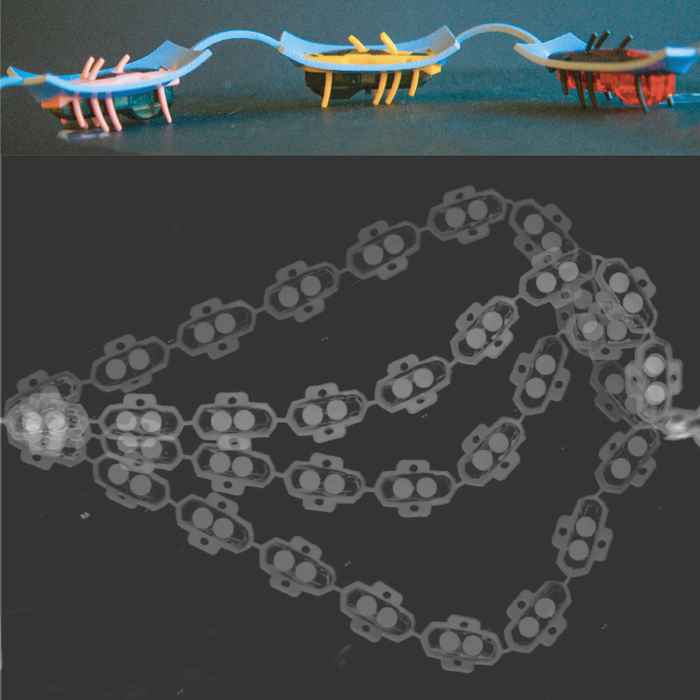Toys demonstrate how biological machines move
1 May 2023

‘Hexbug Nano v2’ microbots use vibrations to propel themselves forward. By connecting several of these toys with an elastic silicon rubber chain, the resulting structure is ‘elastoactive’. This means that it will return to its original shape after being deformed, while the self-propelling, active constituents that it is comprised of constantly try to push the structure in a certain direction.
Depending on the size of the chain links and whether the chains were fixed at one or both ends, the elastoactive chains showed a range of movement types, including self-oscillatory, self-synchronising and self-snapping.
“By experimenting with these elastoactive chains, we discovered that there is an interplay between activity and elasticity: when activity dominates, the chains self-oscillate and synchronize,” says Corentin Coulais, head of the Machine Materials Laboratory at the University of Amsterdam.
He continues: “Mechanical self-oscillation and synchronization are a key feature of biological machines, features that are useful for making new types of autonomous robots. These active chains really allow us to single out the nature of these nonlinear phenomena.”
Self-oscillation, self-synchronisation and self-snapping
When a structure self-oscillates, this means that it bends back and forth by itself. In the chains, the microbots might start by bending the chain to the left. However, because the chain is pinned at one end, the elastic links resist this movement, reorienting the bots in such a way that they start pushing and bending the chain to the right. This movement will again be resisted by the elastic chain, until the bots start moving to the left again.
Synchronisation happens when two elastoactive chains are connected at one end by a stiff enough rod. By wriggling around, the two connected chains automatically start oscillating with the same frequency, like sea grasses moved by the same waves.
Finally, taking a single elastoactive chain and pinning both of its ends, it shows ‘self-snapping’ behaviour. When you bend a playing card with your fingers, you can make it ‘snap’ to bending the other way by pushing hard enough from the side. The elastoactive chains do this by themselves, repeatedly snapping from bending to the left to bending to the right.
Instructive play
“We started this research by just playing around with the microbot toys. But more generally, the idea was to explore materials out of equilibrium. In soft matter, active fluids have been studied extensively in the last 25 years, but their solid counterparts were investigated much less,” says Coulais.
Next on the menu is exploring elastoactive behaviour at smaller scales, for instance in so-called colloidal systems, consisting of small particles suspended in a fluid. Even though these are still model systems, they are closer to the biological system due to similar length scales and the presence of the fluid. At any scale, it would also be interesting to use smart design to embed multiple self-oscillations within a single structure to obtain more complex movement patterns. With a better understanding of self-oscillations, the hope is that it becomes possible to create new types of autonomous robots.
Publication
Self-Oscillation and Synchronization Transitions in Elastoactive Structures, Ellen Zheng, Martin Brandenbourger, Louis Robinet, Peter Schall, Edan Lerner, and Corentin Coulais. Physical Review Letters 130 (2023) 178202,